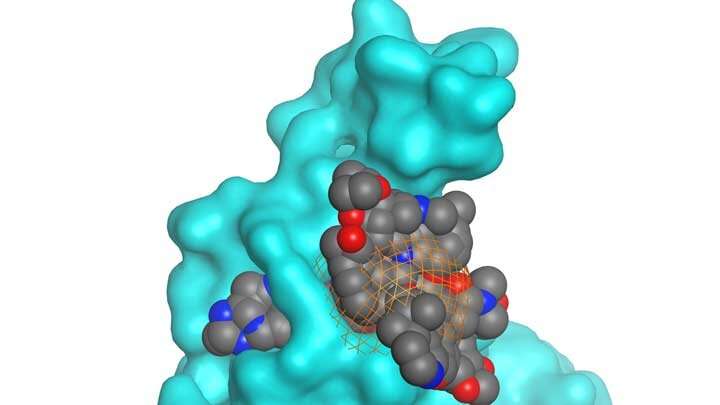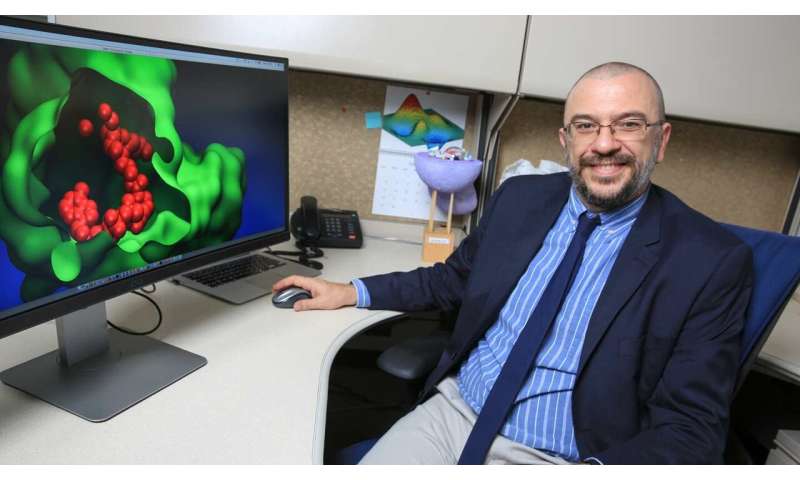Lab finds 125 naturally occurring compounds with potential against COVID-19


The Baudry Lab at The University of Alabama in Huntsville (UAH) has identified 125 naturally occurring compounds that have a computational potential for efficacy against the COVID-19 virus from the first batch of 50,000 rapidly assessed by a supercomputer.
It’s the first time a supercomputer has been used to assess the treatment efficacy of naturally occurring compounds against the proteins made by COVID-19. Located in UAH’s Shelby Center for Science and Technology, the lab is searching for potential precursors to drugs that will help combat the global pandemic using the Hewlett Packard Enterprise (HPE) Cray Sentinel supercomputer.
The UAH team is led by molecular biophysicist Dr. Jerome Baudry (pronounced Bō-dre), the Mrs. Pei-Ling Chan Chair in the Department of Biological Sciences. Dr. Baudry is video blogging about his COVID-19 research journey using HPE’s Cray Sentinel system. His research is in collaboration with the National Center for Natural Products Research at the University of Mississippi School of Pharmacy and HPE.
“We have used supercomputers to predict natural products most likely to bind to three proteins of the SARS-CoV-2 virus,” says Dr. Baudry. SARS-CoV-2 is the scientific name for COVID-19.
“Out of the 50,000 natural products that we have looked at using supercomputers, we find several hundred to be predicted to be potentially binding on the proteins of interest,” he says.
“We further found 125—but there may be more—that are particularly interesting because they bind right where we want to, they are not too big, not too small and they have the chemical profiles of pharmaceuticals.”
There are many diverse natural sources for the chemicals of interest, Dr. Baudry says.
“Many are from relatively common medicinal plants that can be found in the U.S., and many are from more distant plants from Southeast Asia and South America, as well as from some ground and oceanic bacteria strains and fungi.”
Promising compounds will undergo a computational technique called pharmacophore analysis to find what the chemicals have in common and flag chemical features important for future research.
The next phase for the compounds is in vitro testing by a partner laboratory that will use live virus and live cells. Those chemical molecules found most efficacious will form the basis for future drug research and development processes that include testing for efficacy, tolerance and adverse effects in human trials. That process might also include chemical modifications to make the drug more efficient, better tolerated or both.
“Maybe we will need a cocktail of drugs, as is the case in many anti-AIDS treatments. But every drug that ends up surviving this long and winding road of development and testing starts as a hit that binds to a protein. It is this initial event that we are modeling here using supercomputers,” Dr. Baudry says.
“Normally it would take a very long time and a lot of money to achieve that, but with the supercomputers we can perform this initial hit discovery step much faster and cheaper,” he says. “Everything is being accelerated for COVID-19, so the whole process that can take up to a decade may end up being shorter here.”
More batches are being prepared for supercomputer testing, according to Baudry Lab researcher Dr. Kendall Byler, who is running the calculations on Sentinel. Dr. Byler is highly experienced in using computational approaches for natural product research.
“Actually, there are over 400,000 compounds we’d like to test,” Dr. Byler says.

Blocking proteins
In the initial batch, naturally occurring compounds were found that seem likely to bind to two important proteins, COVID-19’s papain-like protease, or PLpro, and the main protease, or Mpro. The proteins are enzymes from the virus’ genome that are responsible for processing all the virus’ proteins in infected cells. Infected cells are forced to manufacture them so that the virus can replicate.
“If we can block these viral proteins from self-assembling and performing their functions inside the cell, we may not have been able to save that one infected cell, but we will prevent the virus from replicating and it will die with that cell,” Dr. Baudry says. “If we find a chemical that ‘sticks’ in these reactive regions of the proteins, the processing reactions will not be possible anymore and we will stop the infected cells from making and releasing more virus.”
The third protein of interest is COVID-19’s spike protein, which is how the virus attaches itself to a cell to initiate the infection process. This spike protein is present on the surface of the virus and gives the virus its characteristic crown-like (corona in Latin) appearance. It binds to a protein called ACE2 on the cell surface to begin the infection process.
“We are trying to find chemicals that would bind on the surface of the virus’ spike protein and prevent it from locking itself with the cell’s ACE2,” Dr. Baudry says.
In the initial batch modeled, scientists found the interactions of 24 compounds interesting in the spike protein, 41 molecules interesting in the main protein and 60 compounds interesting in the PL-pro protein.
“We can then have a good idea of what the natural products exhibit that makes them successful in these different proteins, and that is the starting point for screening larger databases of millions of chemicals much faster, helping chemists to synthesize novel molecules down the road, maybe more potent and more selective than the original natural products against these proteins,” Dr. Baudry says.
AI and ancient knowledge
Located in a Microsoft Azure data center in Texas, the Sentinel supercomputer makes the work more rapid than ever before possible and an HPE team is helping facilitate it. Dr. Baudry’s UAH team has access to Sentinel’s powerful capabilities through the cloud with Microsoft Azure.
Sentinel, which features HPE’s Cray XC50 end-to-end high-performance computing (HPC) system, is capable of computing 147 trillion floating point operations per second and can store 830,000 gigabytes of data.
Sentinel helps to cut compound testing time from months or even years to weeks, Dr. Baudry says. The supercomputer is as fast as the Earth’s entire population doing 20,000 calculations every second and has storage capacity for more than 45 years of high definition video.
The fight to prevent COVID-19’s sometimes devastating health consequences has created a new meeting of modern high-capacity artificial intelligence with humankind’s most ancient healing knowledge, Dr. Baudry says.
Source: Read Full Article